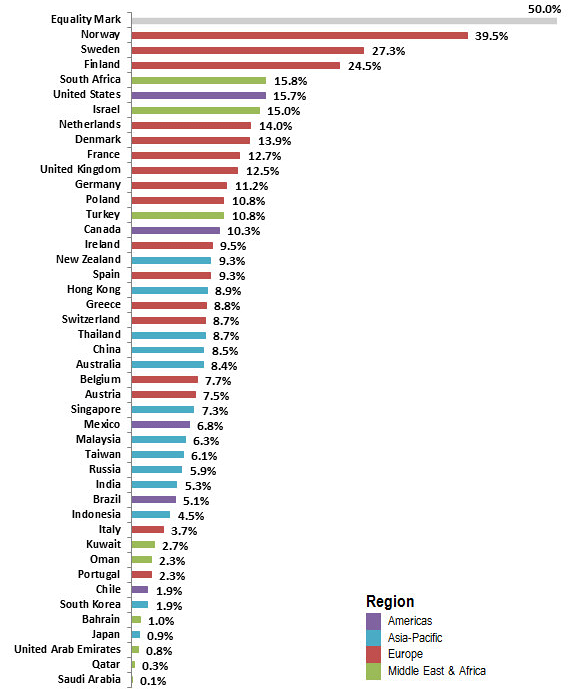Sometimes, though I hate driving, my mind turns to randomly interesting areas. Today, it was gender balance – and I was reflecting on how much of the development work that I’ve done with senior teams puts me in a room full of men. When my classes are full of 50 something senior leaders, it will not be unusual for the group to be entirely male. This empirical observation is borne out by studies across many countries where the ratio of men to women at the top is between 5:1 and 10:1 (roughly, and excluding countries where the ratio is infinite because the number of women at the top approaches zero.

I know that in business and the professions, the numbers who enter are equal, but by the time the top is reached (say the boardroom), we have very skewed outcomes.
Most men at the top are not consciously, or aggressively predisposed to preferentially hiring or promoting men. We can grant that, if asked, they would say they hire on merit. And, being kind, let’s credit men with sincere, good intentions.
However, we know that bias creeps in even when people are very well intentioned. The well documented and proven “similar to me” bias, and the fact that men often associate “good leadership” with male-looking traits tilt the odds in our favor. So a little creeps in against their best intentions. (“Little” is a hypothesis – let us see where it takes us.)
Now let’s run some numbers. If “promoters” and “hirers” are just a tiny bit biased, say 55% likely to promote a male candidate and 45% to promote a woman, then after 3 promotion cycles – the ratio becomes about 2:1 male to female. The mathematical nature of exponents produces a big discrepancy after a short while. (Let us further say that a promotion cycle is five years, although it is mostly much faster than that.)
After six cycles, a thirty year career, the ratio is more than 3:1 starting with just a slender bias toward promoting men. That is just math.
Now let’s take a more extreme case – if a man is twice as likely to promote a man, then after only 3 promotion cycles then ratio is 8:1. After just fifteen years, we see the kind of distributions that we see at the top – my room full of white guys.
Of course, men vary: some may even lean ever so slightly (in theory) toward promoting women, some may achieve balance, but we can probably also agree that the ‘twice as likely to promote a man’ guy is not a rare bird. We can probably also find species who only promote men for dark psychological reasons.
To add slightly to this argument, as we climb the ladder, the ratio of people doing the promoting becomes dominantly male. Further, if a woman misses a year of work (or two) because of an entirely reasonable decision to spend a year with a baby, mathematically she is more likely to miss a round of promotion. By itself, mothers taking time with children mathematically produces differential rates of promotion.
How do we know the extent of these systematic biases? There is probably much research with which I’m unfamiliar, but a proxy we might use is the ratio of salaries. Women earn between 60-90% of what men do for similar positions. Hiring bias probably approximates this salary bias.
So who cares? Apart from, erm, women? (Although recent pronouncements from prominent Republican women politicians decry attempts to address the pay gaps as – go figure – condescending. It seems ignorance can freely cross gender lines.)
There are two obvious concerns. First is loss of talent. If talent is equally distributed at the outset of careers, there is a systematic loss at each promotion level as a less talented man is promoted at the expense of a more talented woman. The same exponential effect applies as earlier – after six cycles, boardrooms are systematically less competent as a result.
Then there is silly old fairness. A free-market ideologue would leave this alone, thinking that the market would address such imbalances over time (even if they agreed it was unfair in the first place.) However, as with wealth distributions across ethnicities, promotion and pay distributions do not start with a level playing field. The distribution of wealth and power in business starts skewed toward men, and (without corrective measures), the bias reinforces itself over each successive generation (promotion cycle). We have further shown that even if the population begins balanced, tiny biases produce large discrepancies over time.
Enter governments and the law. If the market produces a sub-optimal talent pool at the top, and is systematically unfair, we can either shrug our ideological shoulders – que sera, sera – or we can intervene. From my point of view, intervention is clear-cut.
21st century men mean well, yet well documented psychological predispositions bias us. Similarly, the kind of racism that believes people of color belong (by some perverse Calvinism or Social Darwinism) in deprived circumstances are few. We mean well, but forces beyond our control defy our intentions to create fair workplaces and societies.
Those forces, which are mathematical and psychological facts, must be balanced by corrective forces: legislation.

